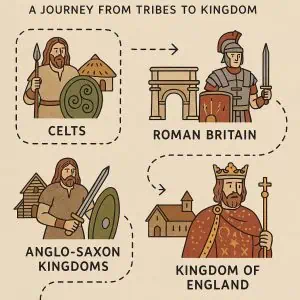When walking through the bustling streets of modern Britain, it’s easy to forget that many of these thoroughfares have existed for centuries, carrying footsteps from medieval merchants, pilgrims, and townsfolk. The UK’s medieval streets are more than just pathways—they are living remnants of history, offering a glimpse into the daily lives of people hundreds of years ago. From the heart of London to the ancient towns of York and Canterbury, these streets tell stories of commerce, religion, and urban development spanning over a millennium.

The Shambles, York
Often considered the best-preserved medieval street in the UK, The Shambles in York dates back to the 14th century, though its origins are older. Its narrow, cobbled lanes, overhanging timber-framed buildings, and historic shopfronts reflect a street designed for pedestrians and carts long before the rise of cars.
💡 The Shambles was originally lined with butcher shops, and some buildings still have meat hooks and troughs visible today!
Today, it’s a bustling tourist destination, yet it retains the charm of its centuries-old architecture.
Watling Street, London
Originally a Roman road, Watling Street became a key medieval thoroughfare running through London. Connecting the city to Roman settlements and later acting as a route for pilgrims and traders, it formed the backbone of medieval London’s transportation network.
💡 Watling Street was once used by royalty and armies traveling across Britain—it wasn’t just for locals!
While the original Roman paving is largely gone, its route remains integral to the modern city.
Pudding Lane, London
Famous worldwide for its role in the Great Fire of 1666, Pudding Lane existed as a medieval street long before that disaster. Narrow and lined with timber-framed houses, it was typical of London streets in the 13th and 14th centuries.
💡 The street got its name from the offal (or “pudding”) that butchers would throw into the nearby Thames.
Walking down Pudding Lane today provides a tangible connection to both medieval life and one of London’s defining historical events.
High Street, Colchester
Colchester, Britain’s oldest recorded town, features streets that trace their roots to Roman times but were fully integrated into medieval urban life. The High Street follows the line of a Roman road and became a hub for commerce during the medieval period.
💡 Colchester was once the Roman capital of Britain, so its medieval streets were built directly on top of ancient Roman routes!
It served as a center for trade, markets, and civic life, and today still preserves aspects of its medieval layout.
St. Martin’s Lane, Canterbury
In Canterbury, a city steeped in religious history, St. Martin’s Lane is one of the oldest streets in continuous use. Originally part of the Roman and Saxon road network, the lane became integral to medieval Canterbury, providing access to the cathedral precincts and surrounding markets.
💡 Pilgrims traveling to Canterbury Cathedral, made famous by Chaucer’s Canterbury Tales, would have walked along St. Martin’s Lane!
This street connects modern visitors with the spiritual and commercial heart of medieval Canterbury.
Castle Street, Cirencester
Cirencester, once the Roman town of Corinium, boasts streets like Castle Street, which preserve a medieval character built atop Roman foundations. Castle Street became a vital artery in medieval trade, connecting the town center to outlying settlements and markets.
💡 Many buildings along Castle Street still display medieval architectural features, including timber framing and traditional cobbles!
Why These Streets Matter
Medieval streets are more than tourist attractions; they are records of urban life, economic networks, and social structures of the Middle Ages. They show how towns developed organically around markets, cathedrals, and city walls, and how ancient roads continued to serve communities long after their initial construction.
💡 The narrow widths, winding layouts, and overhanging buildings of these streets are classic medieval urban design, created when transportation was by foot or horse-drawn cart.
Walking these streets today allows one to step into a living history, imagining the lives of merchants, pilgrims, and townspeople navigating the same pathways centuries ago. Whether it’s the bustling heart of London, the cobbled charm of York, or the ancient streets of Colchester, the UK’s medieval streets remain enduring testaments to the country’s rich historical tapestry.






